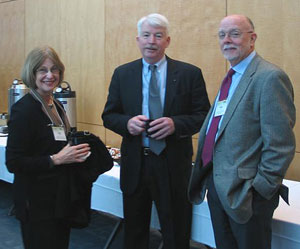
Environmental Factor, May 2008, National Institute of Environmental Health Sciences
Superfund and Worker Training Hold Technical Workshop
By Ted Outwater
May 2008

The NIEHS Superfund Basic Research Program (SBRP)() ![]() and the Worker Education and Training Program (WETP)()
and the Worker Education and Training Program (WETP)() ![]() met at the National Institutes of Health (NIH) campus in Bethesda, Md. April 3-4. The group’s mission was to explore environmental public health connections between the research and training programs and the communities and populations they serve.
met at the National Institutes of Health (NIH) campus in Bethesda, Md. April 3-4. The group’s mission was to explore environmental public health connections between the research and training programs and the communities and populations they serve.
More than 125 NIEHS-funded researchers and educators from 26 states attended. Representing long-time SBRP/WETP partner, the National Institute for Occupational Safety and Health (NIOSH), was John Howard, Ph.D., NIOSH director.
The framework for the conference was set by Thursday’s keynote speaker, Philip Landrigan, M.D., Mt. Sinai School of Medicine. Landrigan focused on the programs’ shared concerns for vulnerable populations, particularly workers and children. His analysis showed that efforts supported by SBRP and WETP, combined with research translation for policy-makers, have contributed to public health successes. Landrigan highlighted a number of other topics, including threats from toxic substances still present in the environment and challenges programs face in striving to make risk assessment more health protective.
The workshop included panel discussions that focused on community-based cumulative risk assessment and protecting disaster site workers (see text box).
In his remarks to attendees, Howard addressed the ongoing role of NIOSH in understanding the health effects that linger from the September 11, 2001 attacks on the World Trade Center. “The most important lesson I have learned,” Howard observed, “...is that when structuring emergency preparedness and response, it is critical to ensure that responder safety and health is treated with as much importance as victim rescue and site recovery. If you fail to achieve parity between victims and responders, you create the ‘after-disaster.’”
A predominant theme emerging in the course of the two-day workshop was that the translation of research to the community, to the workplace and to policy-makers is a process involving partnerships, ongoing two-way communication and planning.
As one SBRP participant noted in an evaluation of the workshop, the meeting “brought home some very practical realizations of how tough it is to translate evolving engineering and science results into practical guidelines aimed at protecting workers and other elevated exposure groups.… The SBRP and WETP did a nice job of focusing what must have been a pretty hard to define and vague initial workshop objective.”
The workshop proceedings will soon be available on-line.
(Contributing writer Ted Outwater is public health educator/program administrator in the NIEHS Worker Education and Training Program)
Building on Past Successes to Meet Future Uncertainties
Four breakout sessions were conducted during the SBRP-WETP workshop. These sessions allowed attendees to make connections with the work that each organization performs and how the programs can work together, while still successfully managing their differences. Following these sessions, attendees recognized the correlation from the research bench to the work bench and vice versa.
Issues discussed during these breakout sessions included preventing exposure through research and training; the need for dialogue, communication and partnerships; emerging issues in remediation, clean production and nanotechnology; and the role of research in protecting disaster site workers.
These issues were related to three major topics discussed during these sessions:
- The ways residents and former workers inhabiting the hills of eastern Kentucky, living in proximity to a Superfund site, can benefit from the nutrition research lead by the SBRP
- The lessons learned from research regarding the pollutants in airline cabins, and their role in helping scientists understand the potential role of human enzymes in detoxification, following certain toxic exposures
- Research into biomarkers of exposure and how differences in individual susceptibility impacts training and procedures for emergency response workers
Gerald Poje, Ph.D., formerly of the U.S. Chemical Safety Board, moderated a final report-back session from the breakout groups. He followed this with an analysis of the current global environmental issues, such as population growth, atmospheric pollution and fossil fuel and fresh water use.
Poje concluded the conference by urging participants to “embrace reality, work together in right relationships, be prepared and have a dream.”
"NTP Seeks..." - previous story ![]()
![]() next story - "Graziano Chosen..."
next story - "Graziano Chosen..."
May 2008 Cover Page



